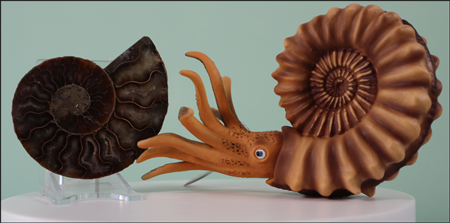Geladas Dig Up an Amazing Ammonite Fossil
Many people enjoy fossil hunting. It is a fascinating hobby. However, we are not the only higher primate that finds fossils. Recently, Everything Dinosaur team members heard of a group of geladas at the Bristol Zoo Project that discovered an ammonite fossil in their enclosure. The bachelor group of geladas dug up a rock to play with, the stone contained an ammonite fossil.

The ammonite fossil discovered by the geladas. Probably from Lower Jurassic sediments, the Avon area is well-known for its Late Triassic and Early Jurassic fossils. Picture credit: Bristol Zoo Project.
Picture credit: Bristol Zoo Project
Geladas Discover an Ammonite Fossil
Geladas (Theropithecus gelada) are a genus of Old World monkey (Catarrhini), native to the Ethiopian Highlands. They are sometimes referred to as “bleeding-heart monkeys” because of their distinctive, heart-shaped chest markings. These robust animals are almost entirely terrestrial. Their diet in the wild mostly consists of grasses. They are extremely social animals and form large, gregarious groups.
Members of the bachelor group were observed playing with a large stone. This turned out to be a fossil ammonite. Geladas often display stone handling, which is a play and foraging behaviour seen in some primates, however the discovery of a fossil is a first for the group.

A pair of geladas in their enclosure. These Old World monkeys found a fossil. Picture credit: the Henstridge Family/Bristol Zoo Project.
Picture credit: The Henstridge Family/Bristol Zoo Project.
Males typically weigh around fifteen to eighteen kilogrammes. Females are smaller. Today, most scientists place the gelada in its own genus. However, genetic studies indicate an affinity with the baboon (Papio). The fossil record of these animals suggests that they evolved during the Pliocene. Several taxa have been described including the much larger Theropithecus brumpti which is known from the late Pliocene of Ethiopia.
Modern geladas have even been reported to use stones for “drawing,” using a stone to mark a surface and even using their finger to spread and adjust the colour. The manus (hand) of the gelada is extremely similar to our own hand. They possess long thumbs, a strong index finger, and the highest thumb-to-digits ratio among catarrhines.
The Bristol Zoo Project is home to six male gelada, Kito, Hobbit, Harshit, Kidame, and recent newcomers Leena, and Takeze who all live in a special area designed to replicate their native landscape in the Ethiopian highlands. The long grasses, rocks and climbing platforms, give them good vantage points and plenty of areas to forage. Furthermore, the underlying rocks have provided the opportunity for these intelligent animals to develop their own fossil collection.
Discovering Ammonite Fossils
Ammonites are extinct molluscs (subclass Ammonoidea). They are closely related to extant cephalopods such as the cuttlefish. Their fossils are common in Mesozoic-aged sedimentary rocks. They are important zonal fossils helping with the relative dating of geological formations. Team members at Everything Dinosaur have quite a big collection of ammonite specimens that they have collected on their fossil hunting adventures.

An ammonite partially eroded out of a nodule. We think this is an example of Dactylioceras commune. Picture credit: Everything Dinosaur.
Picture credit: Everything Dinosaur
It turns out that we hominins are not the only primate with an interest in collecting fossils. Ironically, Everything Dinosaur team members have just despatched some ammonites to fossil collectors based in Dorset. The strongly ribbed models we sent to the fossil collectors represent the ammonite genus Arietites (we think). These ammonite fossils are found in rocks from the Lower Jurassic. The fossil found by the geladas shows large, prominent ribs. Perhaps, this too is a specimen of Arietites.

The Bullyland ammonite model is often used in museum displays to depict the living animal next to fossil material. Picture credit: Everything Dinosaur.
Picture credit: Everything Dinosaur
The picture above shows a polished ammonite fossil next to the Bullyland ammonite figure. This model is extremely popular with the fossil hunting fraternity in Lyme Regis.
To view the Bullyland range of prehistoric animal models: Bullyland Models.
Everything Dinosaur acknowledges the assistance of the Bristol Zoo Project in the compilation of this article.

